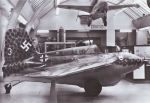
|

|
Concise history from Phil Butler's "War Prizes":
AM214 Messerschmitt Me 163B WNr 191660
Aircraft of JG 400. Surrendered at Husum and shipped to the RAE. Despatched from Farnborough to No. 6 MU, Brize Norton, on 26th July 1945 and from there to the Royal Air Force College at Cranwell on 18th September 1946. AM 214 remained in the Station Museum on Cranwell North airfield until early 1961 when it was handed over to the Imperial War Museum for display at South Lambeth. It was transferred to the IWM airfield site at Duxford in 1976, for refurbishment and subsequent display, there. Its WNr has also been reported as 191060 or 191160 but these reports are in error although the latter number was at one time painted on it at South Lambeth. This aircraft has no connection with the Me 163B which was flown as VF241 as has sometimes been reported - AM 214 was installed in the Cranwell Museum while VF241 was still being flown at Farnborough.
The Imperial War Museum received the aircraft in 1961, and showed it at the Lambeth facility in London. Not many details are known about this period.
It is not 100% sure, but it looks like the Komet had a complete repaint after the war. The aircraft is extremely clean, without a trace of weathering or use. But this could also be the result of never having been flown, not unlikely for a II. Gruppe JG400 aircraft. The code '3' is in an unlikely place, only trainer aircraft had a code on the tail, operational aircraft had it on the fuselage, aft of the iron cross. The Werknummer is painted at the top of both sides of the fin, whereas it should be on the left side only, and lower. The font used looks too modern and definitely not of the specified DIN type. The swastika is of a non-standard type; a late-war swastika should be either completely black, or white outline. Gilbert Haentjens recalled that a FW 190 displayed alongside the Komet was painted in rather garish colors, and must have been a repaint. On the other hand, the stencilling appears to be largely complete (see also the b&w photo), and looks convincing.
Some technical details: the canopy was missing also back then, and a partial tail wheel cover can be seen. It was thought that these were removed after initial trials. The pitot boom is missing, but this could have to to do with the type of display (I don't see any ropes around the aircraft). But apart from these details the aircraft looks to be in great condition.
The postcard scans shown below (courtesy of Gilbert Haentjens and Shamus Reddin) show a number of interesting details.

|

|
Although it was earlier reported that the colors were likely RLM 74, 75, 76, Gilbert Haentjens' color photos shown below clearly show a brown and a green used as topside colors. This is quite remarkable. If we assume we are looking at a postwar repaint, the color choice makes one wonder whether these two colors were picked by accident, or that they were matched against the original colors. In the later case, the brownish color could be one of many RLM81 Braunviolett variations, and the green of the RLM83 variations. Interestingly, the late war colors RLM 81, 82 and 83 were not even known back then. Many modelers paint their Komet and Me 262 models in colors very similar to those seen here. Just compare the colors to that of the Trimaster box art. The camouflage scheme is one that is visible in only a few wartime photographs: center fuselage and wings are painted in a solid dark camouflage (splinter ?) while the nose and tail are covered with dense mottles. The rather dense, relatively hard-edged mottling is not similar to what is usually seen in wartime photos though. The tail mottles appear to be painted on a RLM 02 type base coat. The nose shows a JG400 Geschwader badge, which does not identify a Staffel.

|

|
The photo below shows a 'solid' camouflage. Date is unknown unfortunately, and the background is not confirmed yet as being Duxford.

|
In June 1976 the Imperial War Museum 'outstation' at Duxford was opened. Most likely the Komet was there right from the start. At some time (perhaps before Duxford was opened) it was repainted. The color scheme is rather different than the one it had while on display at South Lambeth. The colors appear to be black green and dark green (RLM 70 & 71, but very much unconfirmed), underside blueish grey. The Werknummer 191660 is now painted in a more conventional position. It is unknown whether it was painted on both sides of the fin (left side only used to be very common on Luftwaffe aircraft). The code "Yellow 3" was retained, but is now painted alongside the cross, which was the usual place for an operational machine. It now has a 7./JG400 badge, a unit that I know close to nothing about! It remained without canopy, but the partial tail wheel cover is gone.
R.L. Bossom worked on the Me 163B in the late 70's, when it had arrived from Lambeth. He reports:
"When it arrived from Lambeth it was painted in four inch paintbrush 'garden gate green' and brown and it was in a dishevelled state. We were asked by the Director to 'tart it up' for display. We had to try and find out as much as possible about 191660 and this proved to be a mammoth task. The markings were not in the correct places, so we had to buy the books by Mano Ziegler and Jeffrey Ethell to try to find out more. I have all the drawings that we gathered together in a file. The photos that you have from Duxford are of the painting that I did over four years. The only mistake was the 'Munchhausen' badge on the port side of the nose, we could not find the original.
We were promised a blown canopy but it never came. The damage to the bullet proof screen appeared in the hanger at Duxford, but I am not sure why. It can not be proved, but it took a heavy landing at some time since the landing skid was misshapen. It may also have been due to ground handling. The cockpit instrument panel was refurbished in my kitchen, as all the wiring had been cut through from behind this panel after the war, so was easy to remove. I found two signatures under a panel on the Port side, below the C stoff tank presumably signed by the RAF fitters.
All the time I worked on it I was amazed at the workmanship and quality of the design of the airframe. I often wondered if I would have to have been very brave or dedicated to sit between T-Stoff and C-Stoff tanks in the cockpit. It is a shame that this project has come to a halt yet again as I would love to see it finished."
R.L. Bossom provided four shots that show the excellent condition of the cockpit interior after he finished the restoration of that part of the aircraft.
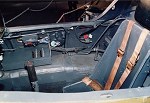
|
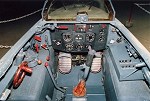
|

|
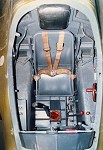
|
The photographs below show the Komet at Duxford in 1990, parked close to a B-17 bomber. These pictures were kindly supplied by Steve Bamford (Victoria, Canada). The colors appear more brownish than in the restoration photographs.
   |
   |
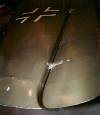  |
In 1997 a complete restoration of the aircraft was started. This was done in the Duxford restoration hangar, which is open for public. Fellow Me 163 fan Ludo Kloek visited Duxford two times and made the following interesting pictures of the dismantled aircraft. Please note that Ludo visited Duxford several times, and thus the pictures show the aircraft in various stages of dismantling. Check the dates listed with the photographs in case of doubts. The restoration pictures show that the aircraft had a complete engine, and MK 108 cannons installed. The cockpit however was very incomplete. This will possibly be rebuilt with other Messerschmitt cockpit parts. A new canopy was made.
Front fuselage |
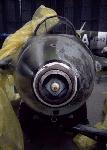
|

|
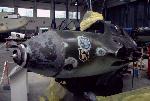
|
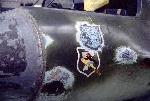
| |
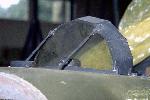
|
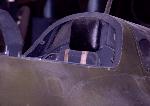
|
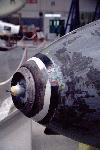
|
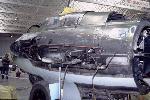
| ||

|

|

|

| ||

|

|

|
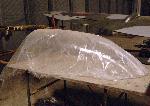
| ||
Rear fuselage |

|

|

|

| |
Right wing |

|

|

|
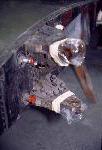
| |
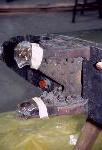
|

|
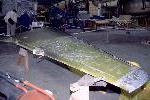
|

| ||
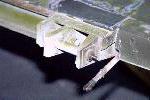
|

|

|

| ||
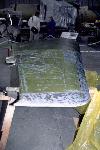
|
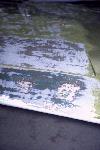
| ||||
Left wing |

|

| |||
Main landing gear |

|

|

|

| |

|

| ||||
Tail landing gear |

|

|

| ||

|

| ||||
Rocket motor |
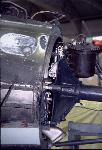
|

|

|

| |

|

|

| |||
Right gun bay
|

|

| |||
Right gun bay
|

|

| |||
Left gun bay
|

|

|
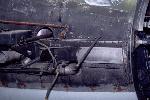
|
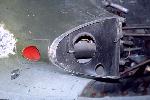
| |
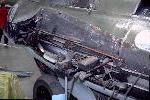
|

|

|
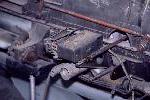
|
After Bf 109G-2 'Black 6' crashed on 12 October 1997, the restoration team that worked on the Komet shifted its attention to the 109, which will be restored to display condition. It seems that since then little or nothing has been done on the Komet. The following photographs (made in 2000) were kindly sent by Peter Marshall. They show that the Komet is no longer in the main restoration hall (as it was until at least 1998), but now stored in one of the smaller side ones.
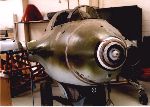
|

|
Hugh Rees visited Duxford in July 2001 and made the following photograph. It appears that little or nothing has changed since 2000.
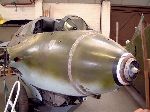
Gordon Mackenzie visited Duxford in 2002, penetrated the museum's defences to gain access to the storage area, and managed to take a close look at the Komet. He made the following photograph that shows the Komet's front fuselage and wings:

More photos of the Duxford Komet can be found on Glijn Van Driessche's Aircraft walkarounds site, with a report of 23 photos.
Early May 2005, the sale of the Duxford Komet was reported by sources in the UK, and somewhere in the week of 16 to 20 May it was loaded on a truck and taken away. It will go to the Flying Heritage Collection, that already had a Komet listed on its planned restoration overview in 2004. Reportedly the Komet was sold for £800,000 to raise money to purchase a de Havilland DH 9, as the IWM doesn't own a WW1 bomber. The sale required the approval of the UK government's Department of Culture, Media and Sport, and that of the IWM Trustees.